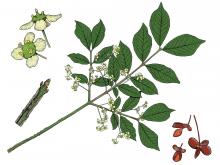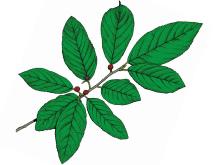Trees, Shrubs and Woody Vines
Media

Species Types
Scientific Name
Ilex decidua
Description
Possum haw, or deciduous holly, is the more common of two native Missouri hollies that lose their leaves each fall. This shrub or small tree is eye-catching in the fall and winter with its bright red berries.
Media

Species Types
Scientific Name
Celtis occidentalis
Description
Common hackberry is named for its sweet, purple, edible fruits, but most people identify hackberry with its weird-looking bark, which develops numerous corky, wartlike projections and ridges.
Media

Species Types
Scientific Name
Ribes missouriense
Description
Missouri gooseberry is our state’s most widespread and common gooseberry. People brave its prickly stems to collect its tart, tasty fruits to make pies, jams, and jellies.
Media

Species Types
Scientific Name
Rosa setigera
Description
Also called climbing rose, prairie rose is most common near woodlands, where it climbs and trails on neighboring shrubs and small trees.
Media

Species Types
Scientific Name
Rubus flagellaris
Description
Dewberry is a lot like common blackberry, except that instead of being a small shrub, its canes form trailing woody vines. Both plants are prickly, and both produce delicious deep purple berries!
Media

Species Types
Scientific Name
Euonymus alatus
Description
Burning bush, or winged euonymus, is a nonnative shrub that has been very popular in landscaping for its bright red fall foliage. But it is invasive and spreads aggressively into natural habitats, displacing native species.
Media

Species Types
Scientific Name
Rhamnus caroliniana (syn. Frangula caroliniana)
Description
Carolina buckthorn occurs in the southeastern half of Missouri. It’s a shrub with several main stems, or a small tree potentially reaching 40 feet high, with a trunk diameter of up to 8 inches. Despite the name, there are no thorns.
See Also
About Trees, Shrubs and Woody Vines in Missouri
There are no sharp dividing lines between trees, shrubs, and woody vines, or even between woody and nonwoody plants. “Wood” is a type of tissue made of cellulose and lignin that many plants develop as they mature — whether they are “woody” or not. Trees are woody plants over 13 feet tall with a single trunk. Shrubs are less than 13 feet tall, with multiple stems. Vines require support or else sprawl over the ground.





















